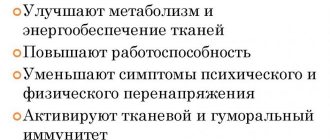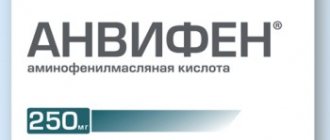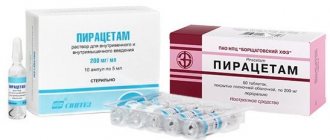Irritability and nervousness have become constant companions in the life of modern man. The consequences of stress are fatigue, depression and uncontrollable outbursts of anger. This not only spoils relationships with others, but also has a detrimental effect on health, leading to the emergence of psychosomatic diseases. If a person is under constant stress, then in order to avoid negative consequences, you can use medications for irritability and nervousness. In order to understand which drug is better to buy, the editors of “I Found” have prepared a list of high-quality pills for anger and aggression.
The mechanism and causes of irritability
Anger is a person’s psychological reaction to a situation that does not suit him. If negative emotions have not found a way out and have been suppressed, then they will certainly manifest themselves in the form of irritability, outbursts of aggression or painful manifestations and the appearance of chronic pathologies.
For example, if an employee at work feels constant pressure from his superiors, this will lead to nervous exhaustion, decreased immunity and will come out in the form of heart disease, kidney disease, respiratory system, digestive tract, etc. In such a situation, the most correct decision would be to contact a psychologist or psychotherapist, who will accurately understand the causes of irritability and prescribe treatment.
Experts identify psychological and medical causes of nervousness and outbursts of anger. Psychological reasons include:
- Constant stress, fears;
- Overwork, chronic fatigue syndrome;
- Alcohol and nicotine addiction;
- Lack of sleep.
The main physiological causes of nervousness:
- Lack of vitamins and microelements in the body;
- Feelings of hunger;
- Hormonal imbalance, often manifests itself during PMS, puberty and menopause;
- Thyroid diseases;
- Diabetes;
- High cholesterol;
- Diseases of the gastrointestinal tract;
- Inflammatory process in the liver;
- Stroke;
- Pathologies of the brain and nervous system.
Treatment
Aggression should not be considered as an inevitable form of human response to conflicts, life difficulties and inconveniences. With timely, correct work on your personal qualities, you can learn to control manifestations of anger and hostility, preventing the development of their pathological forms. Symptomatic medical and psychological assistance consists of psychotherapeutic sessions, group trainings, and medication correction.
Individual psychotherapy
Conversations with a psychotherapist allow patients to understand the reasons for anger, irritability and hostility towards others. Methods of psychoanalysis, psychodrama, and cognitive psychotherapy are used. The result is an awareness of the problem, an understanding of how aggressiveness manifests itself in everyday life, how it affects the quality of relationships, and what methods will be used to correct it. The second stage of psychotherapy is aimed at mastering the skills of self-control, switching attention, and relaxation. Autogenic training, hypnosis, Gestalt therapy and art therapy techniques are used.
Group trainings
Social skills training is effective. Situations are modeled in which examples of adequate behavior are demonstrated, even if the other side provokes a conflict. In the form of role-playing games, methods of interpersonal interaction are practiced in various situations: everyday, professional, official. After each practical lesson, a process of reflection and feedback occurs, in which participants share opinions, experiences, and evaluate the result.
Drug therapy
Selection of drug treatment is necessary for severe forms of aggressiveness, when the patient’s behavior poses a threat to himself or others. Taking medications allows you to achieve compensation for your general condition, reduce the number of aggressive behavioral acts, and prevent their development in the future. The combined use of fast-acting benzodiazepines with antipsychotics is common. Pharmacological effects are explained by the ability of drugs to influence the level and ratio of neurotransmitters. In addition to the above medications, atypical neuroleptics, lithium salts, beta-blockers, and SSRIs can be prescribed.
Ways to cope with anger without pills
Before you think about the question of which pills help with nerves, you can try to cope with manifestations of aggression on your own. We list several effective methods.
- Regular exercise. Physical activity strengthens the nervous system, improves immunity and reduces stress levels.
- Walking in the fresh air improves the functioning of the brain and cardiovascular system, and normalizes the emotional state.
- Creative activities lift your spirits. You can choose dancing, drawing, knitting, etc. to your taste.
- Try to establish normal sleep. An organism that does not get enough rest is naturally susceptible to stress and nervousness.
- Monitor your diet and periodically drink vitamin and mineral complexes.
- Yoga and meditation put thoughts and emotional state in order, normalize sleep, and effectively combat stress and aggressive behavior.
- Try to understand yourself and understand exactly what events cause anger and why this happens.
- Breathing exercises. The easiest option: breathe deeply, starting from the bottom of the lungs and ending with the collarbone area.
- Try to find time to communicate with close friends or just have a pleasant conversation with good acquaintances. An alternative option is to set aside half an hour a day for your favorite activity, be it reading, doing puzzles, watching your favorite TV series, etc.
- Laugh for no reason. When an attack of aggression hits you, you need to find a secluded place and laugh for 3 minutes, then relax and then for 3 minutes experience the negative emotion that you want to get rid of.
- A technique that psychologists call “emotional body therapy.” It will again require a room without people. In the beginning, you need to continue to be angry and observe yourself. Pay special attention to the position in which the body is at this moment. After a few minutes, change your body position and try to relax those areas that were especially tense. For example, it is better to unclench clenched fists, shake them and relax them.
If all of the above methods do not help, then you can turn to anti-stress medications. However, we should not forget that the decision about what is best to consume and how to treat nerves should be made by an experienced doctor.
general characteristics
From a practical point of view, aggressiveness is considered as a person’s increased readiness for aggressive behavior, which is not innate, but acquired in the process of social interaction.
According to qualitative characteristics, aggression is distinguished between constructive and destructive. The first is implemented in defensive actions, causing unintentional harm, allows you to adapt socially, overcome obstacles, and show leadership. The second is represented by unconstructive aggressive actions based on the intent to cause physical or psychological suffering to another. In terms of direction, aggressiveness can be oriented towards others and towards oneself. In accordance with this, heteroaggressive reactions are distinguished - insults, beatings, swearing and self-harming or auto-aggressive reactions. An extreme variant of self-aggression is suicide attempts. The most obvious hostile action is the use of physical force against another person. Other possible options are hostility, malice, negativism, irritation, touchiness, suspicion, and uttering threats. Aggression directed at oneself is accompanied by a feeling of guilt and self-deprecation.
Criteria for choosing a drug for irritability
- Age. Most sedatives are designed for adults; there are special dosage forms for children.
- Allergic reactions to certain groups of substances. In order to avoid getting into an unpleasant and dangerous situation for health, you should carefully study the composition of the drug, main and excipients.
- Pregnancy and lactation period. In this situation, before taking any medications, prior consultation with a specialist is necessary.
- Assessing your own emotional state. For mild stress, you can limit yourself to taking natural-based sedatives or homeopathic medications. In case of severe nervous excitement, you should turn to stronger sedatives or tranquilizers, but only under the supervision of a doctor.
Herbal sedatives
The main advantage of medicines based on herbal ingredients is safety. They put much less strain on the liver, bile ducts and pancreas than synthetic medications. Many herbal sedatives are approved for use by children and adolescents.
Both products based on one component and herbal infusions are equally effective:
- Valerian in tablets, alcohol tincture, capsules and tea briquettes: helps reduce nervous excitement.
- Medicines based on passionflower (passionflower): alkaloids and flavonoids contained in passionflower eliminate irritability, anxiety and groundless fears. Many good medicines for menopausal syndrome have been created on the basis of passionflower (for example, Alora).
- Sedative preparations from motherwort: drops, alcohol tincture, tablets with motherwort extract;
- Anti-irritability tablets based on St. John's wort: Neuroplant, Negrustin. Combines the effects of an antidepressant and a sedative.
Types of anti-anxiety medications
- Sedatives have a mild sedative effect and are most often prescribed for minor nervous disorders. They are of plant origin or bromine-based.
- Tranquilizers are used for nervous psychosis, to relieve irritation, and suppress anxiety.
- Neuroleptics are strong sedatives used in psychiatric practice.
- Antipsychotic drugs are used to stabilize the condition of people with severe mental illness.
- Nootropic drugs are designed to improve brain activity during mental and physical stress.
- Homeopathic medicines are not recognized by official medicine, but often prove their effectiveness during clinical trials.
Groups 3 and 4 are not available from pharmacies without a prescription.
Diagnostics
Diagnosis of aggression and its causes is carried out by a psychiatrist, psychotherapist, or clinical psychologist. Of particular interest are cases of determining the tendency to aggression during examinations, when the patient may have a desire to hide undesirable qualities. In such situations, in addition to standard diagnostic procedures, experimental methods are used, during which influences that provoke hostility are carried out. The following procedures are used as part of the baseline study:
- Survey.
During the conversation, the doctor finds out the reasons for the aggressiveness, its duration, severity, and justification. Patients are not always critical of changes in their behavior, therefore, to obtain more objective information, a survey of relatives (accompanying persons) is carried out, and characteristics from school and place of work are requested. - Observation.
A tendency to aggressive reactions manifests itself during a medical consultation: patients are irritable, quick-tempered, and rude. They answer unpleasant questions with abuse, and easily move on to accusations, quarrels, and scandals. Observation in a hospital setting provides a more complete picture of patient behavior. As a rule, they show verbal and physical aggression and become instigators of quarrels with medical staff and other patients. - Psychodiagnostic testing.
Personality questionnaires make it possible to quantify the severity of aggressiveness, determine its position in the structure of character, and its combination with other qualities, for example, impulsiveness. The Bass-Darki test (Diagnostics of the state of aggression), A. Assinger test (assessment of aggressiveness in relationships) is used. Projective techniques are effective for identifying hidden aggression: the hand test, the Rosenzweig test.
Rating of high-quality herbal anti-irritability tablets
Persen
A popular herbal sedative. Combines the effects of three medicinal herbs: valerian officinalis, peppermint and lemon balm. It is used for increased nervous excitability and insomnia. The drug should be taken regardless of meals, with plenty of water. Price: from 470 to 580 rubles.
Persen
Advantages:
- Natural composition based on herbs;
- Soft, delicate action;
- Has a hypnotic effect;
- Not addictive;
- Does not reduce concentration;
- Not addictive.
Flaws:
- Relatively high price;
- Not suitable for children under 12 years of age;
- Not recommended for pregnant and nursing mothers;
- Possible allergies.
Main characteristics:
| Name | Persen |
| Pharmacological group | Herbal sedative |
| Release form | Pills |
| Main active ingredient | Extracts of valerian, mint, lemon balm |
| Application area | Nervous system diseases |
Novo-passit
Well-known tablets for nervous psychosis effectively relieve irritation and help with attacks of anger. The active ingredient, guaifenzine, normalizes the nervous system, although its main property is the treatment of cough. In addition, the preparations contain extracts of valerian, St. John's wort, lemon balm, elderberry, hawthorn, and passionflower. Take one tablet three times a day before meals. Average price: from 190 to 290 rubles.
Novo-passit
Advantages:
- Fast-acting, the effect occurs in half an hour;
- Natural composition;
- Possible use during pregnancy after permission from the attending physician;
- Relatively inexpensive price.
Flaws:
- Not suitable for children under 12 years of age;
- Drowsiness.
Main characteristics:
| Name | Novo-passit |
| Pharmacological group | Herbal sedative |
| Release form | Pills |
| Main active ingredient | Guaifenzine |
| Application area | Nervous system diseases |
Deprim
A natural sedative designed to combat depression and improve emotional well-being. The active ingredient is St. John's wort extract. The drug is taken one tablet three times a day for adults and one tablet morning and evening for children from 6 to 12 years old. It has a cumulative effect, the first results appear two weeks after the start of use. Its combination with antidepressants and other sedatives is not recommended.
Deprim
Advantages:
- Natural, safe composition;
- Has a gentle effect on the body;
- Can be taken by children from 6 years of age;
- Possible use in pregnant women after consultation with a doctor;
- Normalizes sleep.
Flaws:
- Dispensed with a doctor's prescription;
- Contraindicated in children under 6 years of age;
- Strengthens the skin's reaction to sunlight;
- In some cases, weakness and lethargy are observed.
Main characteristics:
| Name | Deprim |
| Pharmacological group | Herbal sedative |
| Release form | Pills |
| Main active ingredient | St. John's wort extract |
| Application area | Nervous system diseases |
Anxiolytics: yesterday, today, tomorrow
About the article
10261
0
Regular issues of "RMZh" No. 5 dated March 18, 2006 p. 385
Category: General articles
Author: Solovyova I.K.
For quotation:
Solovyova I.K. Anxiolytics: yesterday, today, tomorrow. RMJ. 2006;5:385.
Tranquilizers are pharmacological drugs used to eliminate feelings of fear and/or anxiety (syn. anxiolytics - anti-anxiety drugs), as well as for the treatment of insomnia, complex syndromes (anxiety-depressive, etc.), specific conditions such as panic, obsessiveness, compulsive, social phobias. The use of tranquilizers in the treatment of psychosomatic diseases, somatogenic disorders, and withdrawal states is especially relevant. Thus, these drugs are mainly used in the treatment of generalized anxiety disorder (ICD-10 criteria). Tranquilizers have been known for about 50 years. The development of the first drugs of this group dates back to the 50s of the twentieth century - the period of the emergence of scientific psychopharmacology. The history of the use of anxiolytics began with the introduction into clinical practice of meprobamate (meprotane) in 1955, and chlordiazepoxide (Elenium) in 1959. A year after chlordiazepoxide, diazepam appeared on the pharmaceutical market. Today, the group of tranquilizers includes more than 100 drugs. Their active search and improvement continues. In the most popular series of 1,4-benzodiazepine derivatives alone, more than 3 thousand compounds have been synthesized, of which more than 40 are used in clinical practice.
In the general classification, tranquilizers with antipsychotics traditionally belong to the class of psycholeptics, i.e. drugs generally have a depressive, depressive type of action. However, as will be shown below, a significant number of drugs from different groups are capable of exhibiting anti-anxiety (actually tranquilizing) properties. In particular, such properties are inherent in some antidepressants - drugs that generally have a stimulating effect on mental processes. At the same time, such a classic tranquilizer as dipazepam has an antidepressant effect. These overlapping spectra of pharmacological activity of seemingly completely different drugs indicate the multimodality of psychotropic effects, the exceptional complexity of the mechanisms of various mental disorders that occur with the participation of many neurotransmitters, and the commonality of some neurochemical and neurophysiological links of these disorders. Indications for use are varied: • neurotic, borderline conditions with symptoms of tension, restlessness, anxiety, fear; • psychotic states (anxiety-depressive, affective-delusional, etc.) in combination with antidepressants, antipsychotics; • sleep disorders; • withdrawal disorders in chronic alcoholism and other substance abuse disorders, treatment of alcohol psychoses; • premedication before anesthesia, as a component of combined anesthesia; • psychosomatic diseases (peptic ulcer of the stomach and duodenum, etc.); • cardiovascular disorders with a sympathoadrenal orientation. Contraindications (mainly for BZD): • myasthenia gravis, hypersensitivity to BZD. The most important property of tranquilizers is the elimination of anxiety, feelings of anxiety and fear, the reduction of internal tension, increased irritability, insomnia and other manifestations of neurotic, neurosis-like, psychopathic and psychopath-like states, and autonomic dysfunctions. Therefore, the main target of the use of tranquilizers is various anxiety-phobic syndromes of a non-psychotic level - both acute and chronic, developing within the framework of the so-called borderline states. In addition to the anxiolytic effect itself, the main clinical and pharmacological effects of tranquilizers include sedative, muscle relaxant, anticonvulsant, hypnotic, vegetative stabilizing, and amnestic. Many anxiolytics can also cause drug dependence. However, in individual tranquilizers these properties are expressed to varying degrees, which must always be taken into account when choosing a drug for a particular patient. The improvement of the group under consideration is carried out in the direction of creating drugs with isolated anxiolytic properties, which leads to minimization of side effects. Indeed, the sedative and hypnotic effect of many classical tranquilizers leads to unwanted lethargy, drowsiness, and decreased attention (unless we are talking about their use as sleeping pills). The muscle relaxant effect is important in the treatment of nervous diseases accompanied by increased muscle tone, as well as in anesthesiology; in patients with borderline mental disorders it is generally undesirable. As for amnestic properties, i.e. ability to impair memory, they are almost always a manifestation of a side effect. Among psychotropic drugs, tranquilizers are the most widely used in both inpatient and outpatient treatment. The scope of their use goes far beyond psychiatry, covering many somatic diseases, neurology, surgery, anesthesiology (premedication, ataralgesia), oncology, dermatology, gerontology, pediatrics, obstetrics and gynecology, narcology (for the relief of alcohol withdrawal), and a number of other areas of medicine. These drugs are also used by practically healthy people to relieve the negative effects of emotional stress. As V.I. points out. Borodin, from 10 to 15% of the total population in various countries of the world receive prescriptions for one or another tranquilizer once a year. Benzodiazepines are especially often prescribed. About 2% of the population takes them for a long time. Given such a wide prevalence and high importance of tranquilizers, it is advisable to systematize modern information about this group of drugs, including issues of classification, mechanisms of action, pharmacological effects, as well as side effects and safety of use. The latter is due to the fact that currently in psychopharmacology, priority is given to the safety of treatment, focusing on the importance of comparing clinical effectiveness (the benefit of treatment) and unwanted side effects or tolerability of drugs (the risk of treatment). Classification of tranquilizers Most of the early classifications of tranquilizers are based on the characteristics of their chemical structure, duration of action, and clinical use. Thus, in terms of the number of drugs, the leaders are benzodiazepine derivatives, among which there are long-acting drugs (for example, diazepam, phenazepam, cinazepam, nitrazepam, flunitrazepam), medium-acting drugs (chlordiazepoxide, lorazepam, nozepam, alprazolam, etc.) and short-acting drugs (midazolam, triazolam). Diphenylmethane derivatives include benactizine, 3-methoxybenzoic acid derivatives - trioxazine, substituted propanediol esters - meprobamate, quinuclidine derivatives - oxylidine, azaspirodecanedione derivatives - buspirone. Traditionally, the so-called “daytime tranquilizers” are distinguished, in which the anxiolytic effect itself predominates and the sedative, hypnotic, and muscle relaxant effects are minimally expressed - mezapam, trioxazine, tofisopam; the anxiolytic effect also predominates in gidazepam, tofisopam, and dipotassium clorazepate. These drugs can be prescribed on an outpatient basis during the day. This approach to classification, however, does not take into account the mechanism of action of tranquilizers, which is especially important both for understanding the pharmacodynamics and nature of the side effects, and for determining the main directions for the development of a new generation of drugs. Progressive classifications of anxiolytics based on the mechanism of action are beginning to appear not only in scientific publications, but also in the latest editions of educational literature on pharmacology. In particular, prof. YES. Kharkevich classifies the most important tranquilizers into benzodiazepine receptor agonists (diazepam, phenazepam, etc.), serotonin receptor agonists (buspirone) and drugs of different types of action (benactizine, etc.). The most complete classification of tranquilizers by mechanism of action was developed at the Research Institute of Pharmacology of the Russian Academy of Medical Sciences by T.A. Voronina and S.B. Seredenin. This classification is shown in Table 1. As can be seen from Table 1, due to the influence on various neurotransmitter systems involved in the pathogenesis of anxiety states, the tranquilizing effect is inherent not only in “classical” anxiolytics, but also in drugs belonging to different clinical and pharmacological groups. These are, in particular, the nootropic and cerebrovascular drug aminalon (sometimes referred to as a tranquilonotropic), the muscle relaxant, antispastic and analgesic drug baclofen, the antiemetic drug ondansetron, the antioxidant Mexidol, and the anesthetic drug ketamine. Most of these drugs are not currently prescribed specifically for the correction of anxiety-phobic conditions. The structural homologue of ketamine, phencyclidine, which has a similar mechanism of action (antagonism with glutamate NMDA receptors), is a hallucinogenic drug and is generally not used in clinical medicine as a medicine. In addition, the table does not include numerous drugs described by the authors that are at different stages of development and clinical use. Some of them are used only in experimental medicine. For them, the tranquilizing effect is only one facet of pharmacological activity. These are b-adrenergic blockers (propranolol, etc., which are lipophilic and penetrate well into the brain), since activation of adrenergic systems increases anxiety and fear; the use of b-blockers is especially indicated when anxiety is combined with somatic pathology - angina pectoris, arrhythmias, arterial hypertension; nucleic acid metabolites (uridine, potassium orotate); substances affecting the energy status of the brain, ligands of adenosine receptors (litonite, nicogamol, rubidium nicotinate); hormonal substances (corticotropin-releasing hormone, pineal gland hormone melatonin); cholecystokinin-B receptor antagonists; neuropeptides (neuropeptide Y, enkephalins, prolyl endopeptidase inhibitors, etc.); histamine H3 receptor agonists; antidepressants - tricyclics and MAO-A inhibitors (such as moclobemide, pyrazidol), DOPA decarboxylase inhibitors. Some antipsychotics, narcotic analgesics, nootropics and actoprotectors, sleeping pills, lithium salts, calcium channel blockers, and a number of vitamin complexes also have an anti-anxiety component in the spectrum of pharmacological activity. Side effects of tranquilizers and safety problems of their use In general, tranquilizers, unlike other psychotropic drugs (neuroleptics, antidepressants), are characterized by the absence of severe side effects and good tolerability. IN AND. Borodin identifies the following main side effects that occur when using tranquilizers and are classified as type A: • hypersedation - dose-dependent daytime sleepiness, decreased level of wakefulness, impaired coordination of attention, forgetfulness, etc.; • myorelaxation – relaxation of skeletal muscles, manifested by general weakness, weakness in individual muscle groups; • “behavioral toxicity” – a mild impairment of cognitive functions and psychomotor skills, manifested even in small doses and detected during neuropsychological testing; • “paradoxical” reactions – increased aggressiveness and agitation (excited state), sleep disturbances, usually resolving spontaneously or after reducing the dose; • mental and physical dependence that occurs with long-term use (6–12 months continuously), the manifestations of which resemble neurotic anxiety. These manifestations of side effects are most typical for benzodiazepines, which can also cause arterial hypotension (especially when administered parenterally), dry mouth, dyspepsia (nausea, vomiting, diarrhea or constipation), increased appetite and food consumption, dysuria (urinary disorders) , violation of sexual desire and potency. Benzodiazepines can increase intraocular pressure and are therefore contraindicated in angle-closure glaucoma. With prolonged use, tolerance is possible. Allergic reactions are rare. The leading ones in frequency are lethargy and drowsiness, which occur in approximately 10% of cases, including the next day as part of “residual effects” after the evening dose of the drug the day before. Dizziness and ataxia (impaired coordination of movements) associated with muscle relaxation are 5–10 times less common. However, in old age, the side effects in question become more frequent. Due to these properties, myasthenia gravis is a contraindication to the use of tranquilizers. The deepening of sleep and muscle relaxation caused by tranquilizers determine such a contraindication to their use as sleep apnea syndrome - long breathing pauses during sleep, usually occurring in snoring patients. In this case, hypoxia occurs, and myocardial ischemia may develop. Tranquilizers make it difficult to awaken when breathing stops, and relaxation of the soft palate muscle, which sag and prevents the flow of air into the larynx and further into the trachea, leads to worsening hypoxia. In this regard, it is appropriate to recall the old recommendation to refrain from using any sleeping pills in patients who snore. Memory impairment is a manifestation of “behavioral toxicity” and is characterized by episodes of anterograde amnesia (decreased memory for events that occurred after taking the drug), especially when taking benzodiazepine tranquilizers with a pronounced hypnosedative effect, including dipotassium clorazepate. It is also possible to have a reversible impairment in remembering and reproducing information due to long-term use of classic benzodiazepine drugs, such as diazepam, phenazepam, but not new generation drugs - alprazolam or buspirone. An increase in aggressiveness as a manifestation of “paradoxical” reactions can be caused by triazolam, and therefore it is recommended to take this drug for no more than 10 days only as a hypnotic, as well as dipotassium clorazepate. Increased aggressiveness or agitation can be quite difficult to clearly associate with taking tranquilizers; it may be a manifestation of the course of the disease, and not a side effect of the drugs in question. Due to the adverse effects on the fetus, anxiolytics are contraindicated during pregnancy. Tranquilizers, primarily benzodiazepines, easily cross the placenta. Tranquilizers pass into breast milk. The problem of drug dependence on tranquilizers is interpreted ambiguously by experts. Most authors agree that its risk is directly proportional to the duration of treatment with tranquilizers. Dependence to benzodiazepines, including lorazepam, is especially likely. Meprobamate is also dangerous in this regard, the peculiarity of its action is the development of euphoria. Withdrawal syndrome indicates the occurrence of physical dependence. Its manifestations are gastrointestinal disorders, sweating, tremors, drowsiness, dizziness, headache, intolerance to sharp sounds and smells, tinnitus, irritability, anxiety, insomnia, depersonalization (a feeling of loss of one’s own self and the experience of a lack of emotional involvement in relationships to loved ones, to work, etc.). As a rule, it is not severe. The severity and duration of withdrawal symptoms may be underestimated and mistaken for neurotic manifestations of the patient's illness. At the same time, there are frequent examples of long-term (months and even years) use of benzodiazepines without difficulties in subsequent withdrawal, which is facilitated by certain tactics of treatment and drug withdrawal. To prevent withdrawal during long-term treatment, lower doses, fractional short courses of therapy should be used, and withdrawal should be carried out within 1-2 months against the background of psychotherapy or placebo. It may be recommended to replace the short-acting drug with a long-acting drug in equivalent doses, and the rate of dose reduction should be approximately 25% for each quarter of the withdrawal period. Long-term treatment (with good tolerance and absence of tolerance) is possible in elderly patients in whom benzodiazepines relieve symptoms well in small doses. A new selective anxiolytic Afobazole It is impossible not to pay great attention to a new anxiolytic drug. The data obtained made it possible to formulate a concept of the mechanism of action and chemical structure of a new original compound that prevents anxiogenesis, on the basis of which the pharmacological drug Afobazol was created, which is currently successfully undergoing clinical trials. Afobazol is the world's first selective anxiolytic, devoid of the side effects of benzodiazepine tranquilizers: hypnosedative action, muscle relaxant effect, memory disorders, etc. Afobazol has received patents from the Russian Federation, the USA, Europe and Japan. Afobazole is ideal for working people who have superficial disorders associated with anxiety, and they need it in order to, as they say, hide from the difficulties of life, stress and worries. On the other hand, it is of great importance for people forced to act in extreme situations. Afobazole is a selective non-benzodiazepine anxiolytic. It has a combined anti-anxiety and easily stimulating (activating) effect. When using it, drug dependence does not form and withdrawal syndrome does not occur. Afobazole has an anxiolytic effect with an activating component, not accompanied by hypnosedative effects (sedative effects are detected in Afobazole in doses 40-50 times higher than the ED50 for anxiolytic action). The drug does not have muscle relaxant properties or a negative effect on memory and attention; Drug dependence does not form and withdrawal syndrome does not develop while taking the drug. The effect of the drug is implemented mainly in the form of a combination of anxiolytic (anti -aircraft) and easily stimulating (activating) effects. Reducing or eliminating anxiety (concern, poor forebodings, fears, irritability), tension (shyness, tearfulness, feeling of anxiety, inability to relax, insomnia, fear) and, consequently, somatic (muscle, sensory, cardiovascular, respiratory, gastrointestinal symptoms ), vegetative (dry mouth, sweating, dizziness), cognitive (difficulties in concentration, weakened memory) of disorders are observed on 5-7 days of treatment with apobasol. The maximum effect is achieved by the end of 4 weeks of treatment and persists in the post-therapeutic period, on average 1-2 weeks. The use of the drug is especially indicated in persons with predominantly asthenic personality traits in the form of anxious suspiciousness, uncertainty, increased vulnerability and emotional lability, and a tendency to emotional stress reactions. Afobazole is non -toxic (LD50 in rats is 1.1 g at ED50 0.001 g). The half -life of the apobasole when oral administration is 0.82 hours, the average maximum concentration (CMAX) is 0.130 ± 0.073 μg/ml, the average deduction of the drug in the body (MRT) is 1.60 ± 0.86 hours. Afobazole is intensively distributed into well vascularized organs. It is used inside, after eating. Optimal one -time doses of the drug - 10 mg, per diem - 30 mg, distributed into 3 doses during the day. The duration of the terminal use of the drug is 2-4 weeks. If necessary, the daily dose of the drug can be increased to 60 mg.
Content is licensed under a Creative Commons Attribution 4.0 International License.
Share the article on social networks
Recommend the article to your colleagues
List of the best safe medications for stress
Tenoten
A soothing drug with a mild and effective effect. The remedy is indicated for people with various types of anxiety disorders, as well as in frequent stressful situations. Relieves anxiety and irritability, equalizes the psychological state. Does not have a sedative effect.
The drug is often prescribed for complaints of increased sensitivity to familiar events and nervousness. Normalizes condition and mood. In children it effectively combats hyperactivity and restlessness.
Tenoten
Advantages:
- Soft action;
- Improved mental state;
- Available for adults and children;
- Compatible with other medications.
Flaws:
- Individual intolerance is possible.
- Not the cheapest drug.
Main characteristics:
| Name | Tenoten |
| Pharmacological group | Homeopathic medicine |
| Release form | Lozenges |
| Main active ingredient | Antibodies to brain-specific protein S-100 affinity purified in the form of a water-alcohol mixture |
| Application area | Nervous system diseases |
Afobazole
A completely artificial drug that does not contain natural plant components. The main active ingredient, Fabomotizole dihydrochloride, selectively affects brain cells, calms, and helps with anxiety and inner anger. Taken three times a day after meals. Price: from 360 to 480 rubles.
Afobazole
Advantages:
- Does not cause drowsiness;
- It is possible to combine the drug with alcoholic beverages;
- Fights insomnia.
Flaws:
- Completely artificial drug, no natural ingredients;
- Contraindicated in children under 18 years of age;
- Do not use during pregnancy or breastfeeding.
Main characteristics:
| Name | Afobazole |
| Pharmacological group | Tranquilizer |
| Release form | Pills |
| Main active ingredient | Fabomotizole dihydrochloride |
| Application area | Nervous system diseases |
Combined sedatives
Combining different herbal components allows you to mutually enhance their therapeutic effect with a fairly small dosage. The best sedative multicomponent drugs:
- Adonis Bromine – based on Adonis and Potassium Bromide: has a sedative and cardiotonic effect.
- Bromcamphor - acts similarly to other bromides: it has a sedative effect, normalizes sleep, eliminates anxiety, and enhances brain inhibition processes.
- Valocordin - reduces the activity of the central nervous system, produces a mild hypnotic effect.
- Dormiplant is a medicinal mixture of lemon balm and valerian. Available in tablets and alcohol tinctures. Dormiplant can be taken if you have high nervousness or problems controlling aggression.
- Novopassit is a mixture based on lemon balm, valerian, passionflower, St. John's wort, hops, hawthorn and elderberry with guaifenesin. Prescribed for irritability and nervousness, groundless fears and mild neurasthenia.
- Nervoflux is a tea mixture of valerian, hop cones, lavender, bitter orange, mint and licorice. Purpose – chronic stress, problems falling asleep.
- Persen and Persen Forte - (identical preparations, the only difference: the first contains 50 mg of valerian, the second 125). Persen stabilizes the nervous state, reduces excitability and improves sleep quality (if sleep disturbances are the main reason for taking the medicine, it is better to choose Persen “Night”). The drug is contraindicated for hypotension, lactase deficiency and fructose intolerance.
- Calm is a homeopathic remedy, the active substances of which are: zincum valerianicum, cohosh racemosa and ctrichnos ignatia. Prescribed without a prescription for irritability, nervous excitability, as well as for neuroses with cardiovascular disorders.
- Phytosed is a medicinal mixture of hops, motherwort, lemon balm, sweet clover, oats, coriander and hawthorn infused with alcohol (not recommended during pregnancy or when driving). The collection relieves nervous tension and anxiety.
- Phytosedan 2 is a herbal mixture based on mint, motherwort, licorice root, hops and valerian. Phytosedan 3 is a collection based on sweet clover, valerian, oregano, motherwort and thyme. These medications can be taken for high nervous excitability, neurosis, and migraines. An allergy to one of the components of the collection may be a contraindication.
Well-known budget nootropics used for irritability and stress.
Pantogam
Used to prevent oxygen starvation, strengthen memory, attention, and concentration. It has a slight calming effect, reduces irritability, and helps with fatigue, which is especially important for people who work at a computer. It is recommended to take in the first half of the day, half an hour after meals. The drug can be taken by adults and children from birth. The dosage in this case is calculated by the doctor. The price of tablets varies from 400 to 480 rubles.
Pantogam
Advantages:
- Possible use in children;
- If side effects occur, it is enough to reduce the dosage to neutralize them;
- Increases mental and physical performance.
Flaws:
- In some cases, drowsiness and lethargy are observed;
- High price;
- It is forbidden to drink during pregnancy and during breastfeeding.
Main characteristics:
| Name | Pantogam |
| Pharmacological group | Nootropics |
| Release form | Pills |
| Main active ingredient | Rac-hopantenic acid |
| Application area | Nervous system diseases |
Phenibut
A safe and effective medicine belonging to the group of new generation nootropics. Strengthens and improves brain activity, restores strength, helps with stress and irritability. The drug can be taken by children after consulting a specialist. Active ingredient: aminophenylbutyric acid. The price depends on the number of tablets in the package, varies from 60 to 450 rubles.
Phenibut
Advantages:
- Safe composition;
- Has a mild hypnotic effect;
- Helps with headaches, seasickness;
- Can be taken by children.
Flaws:
- Long-term use of the drug may adversely affect liver function;
- Contraindicated during pregnancy.
Main characteristics:
| Name | Phenibut |
| Pharmacological group | Psychostimulants and nootropics |
| Release form | Pills |
| Main active ingredient | Aminophenylbutyric acid |
| Application area | Nervous system diseases |
Glycine
A time-tested drug that improves brain metabolism. It has been used for many years to support the nervous system, reduces nervous excitement, irritability and anxiety. The drug has virtually no contraindications; it can be used as a safe sleeping pill for children. It comes in the form of small tablets that need to be dissolved slowly under the tongue. The price for 50 tablets does not exceed 40 rubles.
Glycine
Advantages:
- No contraindications;
- Low price;
- Safe composition;
- Can be used by children;
- Has a slight hypnotic effect;
- Improves memory and concentration.
Flaws:
- It may be ineffective in cases of severe stress and attacks of aggression.
Main characteristics:
| Name | Glycine |
| Pharmacological group | A drug that improves brain metabolism |
| Release form | Pills |
| Main active ingredient | Glycine |
| Application area | Nervous system diseases |
Mechanism of action of sedatives
Calming medications are necessary to relieve emotional stress and irritability. Drugs that help the nervous system relax and recover after a long stay in a stressful situation are divided into two types according to their composition:
- chemical;
- vegetable.
Both types of medications depress the nervous system to varying degrees of intensity. Unlike antidepressants, which require a doctor's prescription, the effects of sedatives are less pronounced. In addition to the nervous system, sedatives also affect the brain, and therefore can cause some difficulties in normal life activities.
Rating of effective homeopathic remedies for irritability and nervousness
Calm down
Budget homeopathic medicine for adults. Convenient dragee form. Prescribed for increased excitability and nervousness. The drug is taken in the morning 15 minutes before breakfast. During stressful situations, the dosage can be increased to three tablets per day. The average price does not exceed 100 rubles.
Calm down jelly beans
Advantages:
- Low price;
- Natural safe composition;
- Normalizes sleep;
- Does not cause drowsiness or addiction.
Flaws:
- Not proven effectiveness;
- Contraindicated for children under 18 years of age and pregnant women.
Main characteristics:
| Name | Calm down |
| Pharmacological group | Homeopathic medicine |
| Release form | Lozenges |
| Main active ingredient | Zincum isovalerianicum, Zincum valerianicum |
| Application area | Nervous system diseases |






